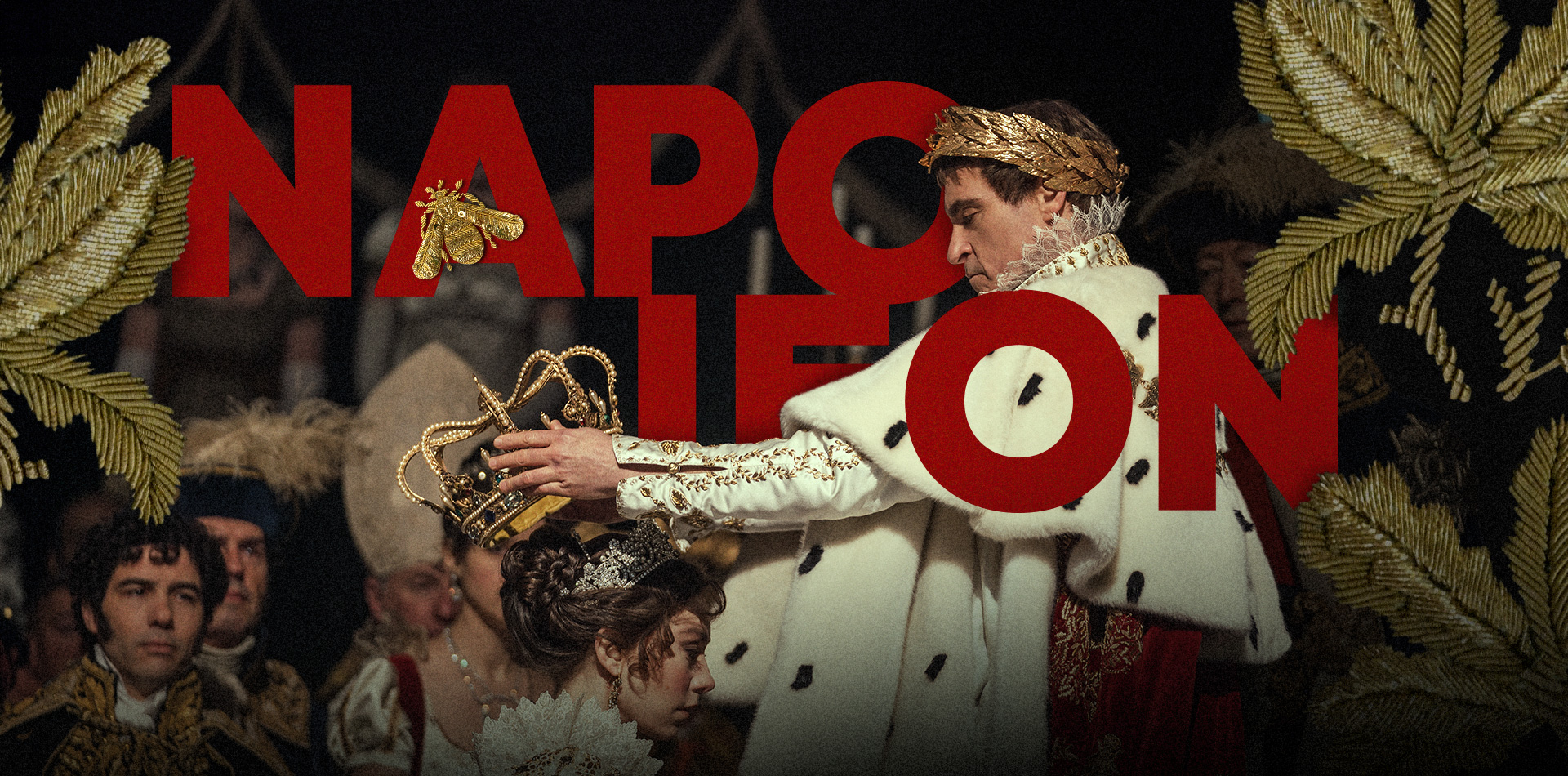By Anna Wyckoff | December 4, 2023
Napoleon
Napoleon was an outsider who rose to heights of authority to rival any world ruler. The Corsican soldier maneuvered through the muck of some of history’s bloodiest battlefields and most powerful royal courts, using charisma and the cult of celebrity to his advantage in both arenas. When Bonaparte donned the velvet, ermine-trimmed mantle and crowned himself Emperor of France—an image captured in the dazzling Jacques-Louis David painting in the Louvre—he reached a pinnacle of glory beyond the wildest imagination of anyone except, perhaps, himself. It would be all downhill from there.
The film Napoleon is costume designer Janty Yates’ 14th collaboration with director Ridley Scott. She built Rome in a few months for Gladiator, collecting an Academy Award in the process, envisioned the future in The Martian, and brought 12th century medieval religious conflict to vivid life in Kingdom of Heaven. For this latest venture, Yates partnered with co-costume designer David Crossman, who focused on the extensive military costumes. Together they accomplish a fidelity to personality, period, and realism worthy of Piero Tosi.
Politics and Propaganda
Napoleon is one of the most documented historical figures, but abundant imagery and information leaves no margin for error in depiction. Yates and her team made full use of the wealth of research available. In addition to written sources, they turned to many French military and art museums.
They viewed firsthand paintings by David, his protégé Ingres, and Gérard, among many others, studying Napoleon’s strategic image, which underscored and reinforced his political ambitions. Other painters like Delaroche captured Napoleon’s brooding humanity, which dovetails perfectly into Joaquin Phoenix’s nuanced performance in the film. The challenge came to translate these indelible images into garments that allow the audience to recognize the myth and understand the man.
Mervielleuse to Malmaison
Perhaps Napoleon’s only rival in ambition was his wife, Josephine. When they meet, we immediately wonder who is pursuing whom. Born in Martinique, she survived imprisonment as a widow of the Revolution—her husband, the father of her children, having gone to the guillotine. Yates depicts Josephine in startling contrast to Marie Antoinette, whose ruination and regicide open the film. Her exquisitely embroidered diaphanous gowns epitomize the Directoire style, shunning panniers and obvious opulence to return to a classical Roman aesthetic.
In a time when clothing telegraphed symbolism to allies and foes, Napoleon adopted the bee as an emblem to distinguish his reign from the fleur-de-lis of the previous Bourbon monarchy. “We were sewing little gold bees for three weeks onto one dress,” says Yates. Although the look symbolized a return to purity, the flimsy, décolleté, muslin gowns of the Mervielleuse, chased in gold or sliver threads, in a culture accustomed to women being upholstered with garments, were shamelessly erotic.
Josephine’s jewelry was also a studied contrast to the fashionable diamonds and pearls of her predecessors. The cameo and intaglios, which referenced Rome, set by her jewelers were a perfect accompaniment to the austerity of her chemise dress à l’antique. Yates visited the Paris exhibit of Josephine’s jewels no less than six times. The results appear throughout the film, but most noticeably in the coronation scene where diadems and crowns glint with power and grandeur. After the divorce, Josephine retired to Malmaison. Yates quips, “I didn’t think she’d be Mrs. Miggins entertaining Tsar Alexander. I thought she’d still maintain her dignity.” She had dresses created with a more pastoral feel, with floral embroideries, perhaps a nod to Josephine’s aptitude for horticulture, which she exhibited at her estate.
Mantle and Myth
“Working with Joaquin Phoenix—playing another emperor, no less—was very easy, with lots of banter,” chuckles Yates. She and Crossman sent costumes to New York and conducted fittings on Zoom, having an assistant dress the actor. Building the costumes did require accommodating the actor and Crossman’s ethical concerns. Because they are vegan, the distinctive, bicorne hats were made of tree bark. Pleather and faux fur were also used.
Clothing a Napoleonic battle in 2023 requires marshaling a small army of tailors, embroiderers, dyers, and costumers. The number of background actors was formidable, from 700 at Toulon, 500 at Austerlitz, 900 at Waterloo, and 200 Prussian infantry, as well as 500 additional soldiers.
There are only a handful of scenes that have both military and civilian costumes. Yates explains, “David is a military designer and he’s an absolute stickler for accuracy. Every general’s embroidery was planned eight weeks in advance, even before we had an actor cast. We had to send off collars, cuffs, and backs of jackets because the embroidery runs up the center back.”
The self-coronation scene was an exercise in bringing a tableau to life. Clergy, commanders, and courtiers are arranged in a panoply focused on the man who would be emperor. Yates filled the frame with the most beautiful embroidered pieces and “as many sparkling jewels as we could lay our hands on.” For a costume designer, certain moments encapsulate the vocation, and for Yates this was one of them. She says, “When you’re designing the cape, the gown, the ladies-in-waiting, having them embroidered, attaching ribbons with jewels in them, you’re not quite sure how it’s going to come together. I was extremely emotional that day in the cathedral because it actually all worked.”



